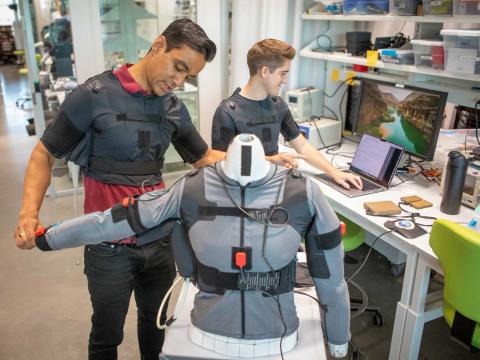Gremlins to Use Collaborative Autonomy Technology
The fourth and final phase of the Gremlins unmanned aerial system program will include collaborative autonomy software that allows one person to control multiple unmanned air vehicles. The technology extends the capability of unmanned aircraft systems to conduct long-distance engagements of mobile ground and maritime targets in areas with poor communications or limited navigational signals.
The Defense Advanced Research Projects Agency (DARPA) and the U.S. Air Force agreed earlier this year to add a fourth phase to DARPA’s Gremlins program. The program was expected to complete Phase III by the end of the calendar year and then move into the additional stage. That fourth phase, which the Air Force is partially funding, will be used to prepare the technology for Air Force operations and to help determine the operating concepts for the systems.
The final tests will include collaborative autonomy technology that DARPA developed under the Collaborative Operations in a Denied Environment (CODE) program. That technology has since transitioned to Naval Air Systems Command.
Most unmanned air systems demand continuous control by a dedicated pilot and sensor operator supported by numerous telemetry-linked analysts. This requirement severely limits the scalability and cost-effectiveness of unmanned air operations and compounds the operational challenges in contested electromagnetic environments, according to DARPA’s website. The CODE technology is designed to overcome those limitations with new algorithms and software that would extend mission capabilities and improve the ability to conduct operations in so-called denied or contested airspace where communications and GPS-enabled navigation are difficult. The website describes CODE technology as “a modular software architecture beyond the current state of the art that is resilient to bandwidth limitations and communications disruptions.”
DARPA completed the CODE program last year. “We have since transitioned that program to [Naval Air Systems Command], but we knew that it was somewhat brittle. There were certain things we knew you could do that would make the system hang up a little bit or just not do exactly what you wanted because it was still a developmental program,” says Scott Wierzbanowski, who served as DARPA’s CODE program manager and who manages the Gremlins program as well.
Incorporating CODES onto the Gremlins unmanned systems will help answer the “what-ifs,” he explains. For example, officials hope to determine how to reestablish a connection or re-plan a mission when communications are lost. “We’re taking that foundational work that we did in autonomy, and we’re going to build upon it as we work with these Gremlin air vehicles,” Wierzbanowski states.
He lists that collaborative autonomy as the biggest challenge the agency would like to overcome in the final phase of the Gremlins program. “It’s going to be working on the ability for the autonomy to work when pop-up threats are happening. What we demonstrated in CODE was excellent. It was really a significant step forward in how autonomy can work for heterogenous systems.”
DARPA demonstrated CODE’s capabilities using a combination of six real and 24 simulated RG-23 TigerShark unmanned systems built by Navmar Applied Sciences Corporation. The systems worked together to conduct suppression of enemy air defenses (SEAD) missions, strike missions and intelligence, surveillance and reconnaissance missions.
Depending on how warfighters choose to use the Gremlins, which are built by Dynetics, a Leidos company, the unmanned systems might also benefit from another former DARPA program, the Persistent Close Air Support program. That effort developed technology designed to fundamentally increase close air support effectiveness by enabling personnel on the ground and combat aircrews to share real-time situational awareness and weapons systems data. The system enables ground agents to quickly and positively identify multiple targets simultaneously.
“What it really comes down to is the concept of operations. We envisioned different ways the Gremlin vehicles could be used. If you wanted to launch these vehicles, and then allow a ground agent to take control to do the intelligence, surveillance and reconnaissance mission, that is one concept of operations that could work, and you could leverage a strategic use of unmanned air vehicles within a very close tactical setting,” Wierzbanowski suggests.
Another possibility, he explains, will be to have someone control the unmanned systems from aboard whichever aircraft might be used to launch the Gremlins. “The goal is to demonstrate that a single operator can control multiple unmanned aerial vehicles in complex mission scenarios. During Phase IV, an operator would be able to launch, control, and recover multiple Gremlin air vehicles from a host aircraft. This would demonstrate to the services that the technologies needed to conduct distributed air operations is mature enough to be considered in future programs of record.”
While the Gremlins can be launched from virtually any type of military aircraft, including transport planes, fighters and bombers, they will need to return to a C-130 simply because that is the aircraft the recovery system was designed to fit. The recovery system is a mechanical arm that extends from the rear of the aircraft and connects to the drones.
It is even possible, but probably not practical, for the military services to attach weapons to the drones. Wierzbanowski explains that the unmanned systems are designed to carry roughly 150 pounds of sensors in the nose. Adding weapon systems would require reengineering the craft to integrate the weapons in the middle to maintain ballast. In the end, it is more feasible to simply launch an existing weapon system, such as Lockheed Martin’s Joint Air-to-Surface Standoff Missile.
“This vehicle is made for sensors and nonkinetic capabilities. My take is that if you really want to put weapons on it, then just go ahead and use a weapon that we already have,” Wierzbanowski declares. “If you really wanted to have a vehicle like this that was going to release something, well, it would be small, but I think it’s going to be an inefficient way.”
In addition to the Air Force, both the Navy and the special operations community have shown interest, Wierzbanowski reports. The Navy officials, he notes, like the idea of having a system they can launch from aircraft already aboard aircraft carriers rather than having to design a whole new plane. And special operations forces are interested in having an intelligence, surveillance and reconnaissance system they can own and operate rather than requesting support from unmanned systems controlled by others, such as a Predator or Reaper.
The additional stage of the Gremlins program, Wierzbanowski states, is where it starts to get fun. “This is where we switch hats from the developmental test perspective and start looking through the lens of an operational tester.”
The effort likely will incorporate a variety of sensors on the unmanned systems. “While we are still working out the details the intent is to demonstrate the integration of different intelligence, surveillance and reconnaissance sensors within an autonomous formation of unmanned aerial vehicles,” Wierzbanowski offers.
The added phase is expected to last about 27 months. “We wanted to keep it short so that from a DARPA perspective, it’s scoped, and when we’re done, we’re done. Then it becomes the responsibility of the service to move forward with it if they deem it worthy,” Wierzbanowski says.






Comments